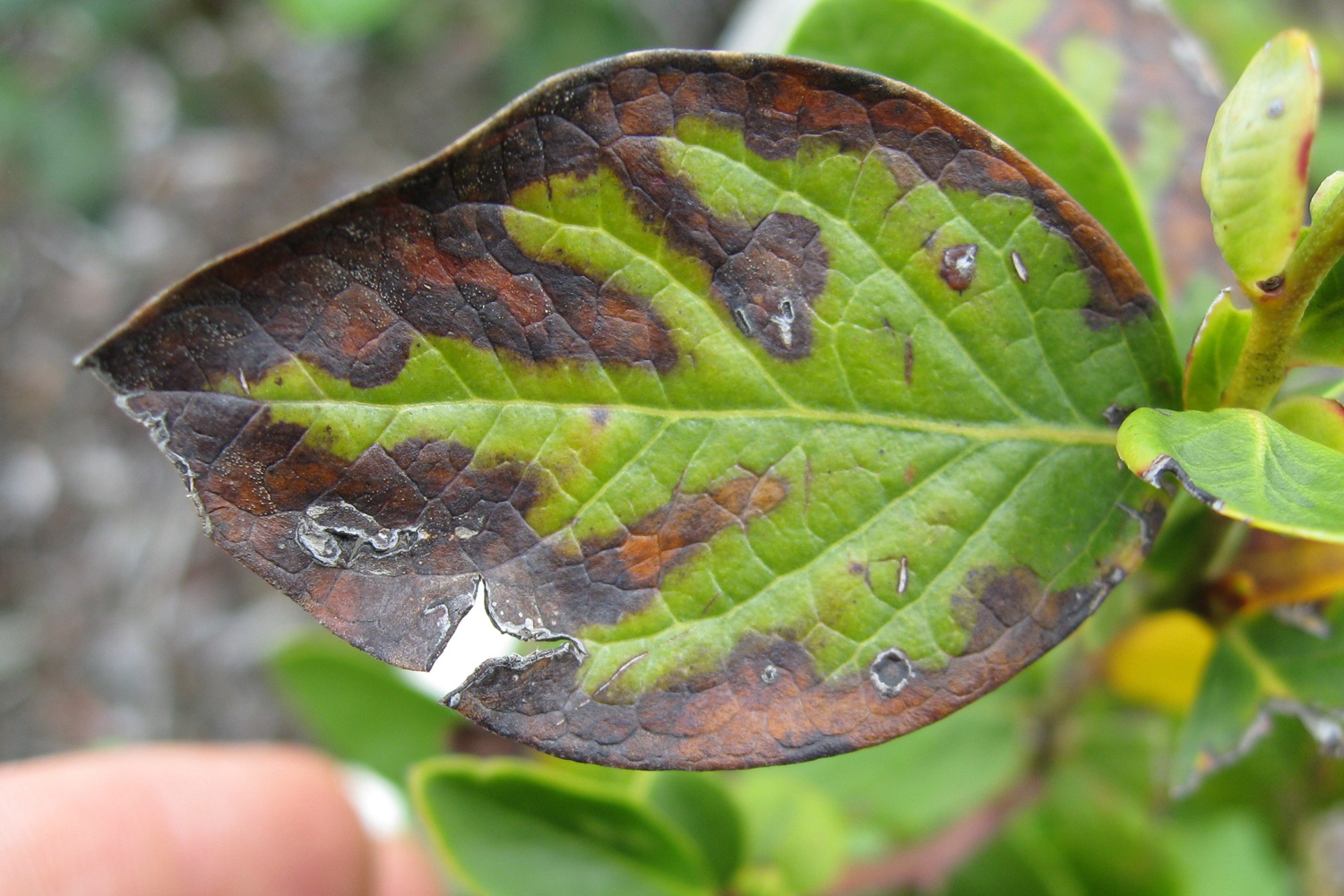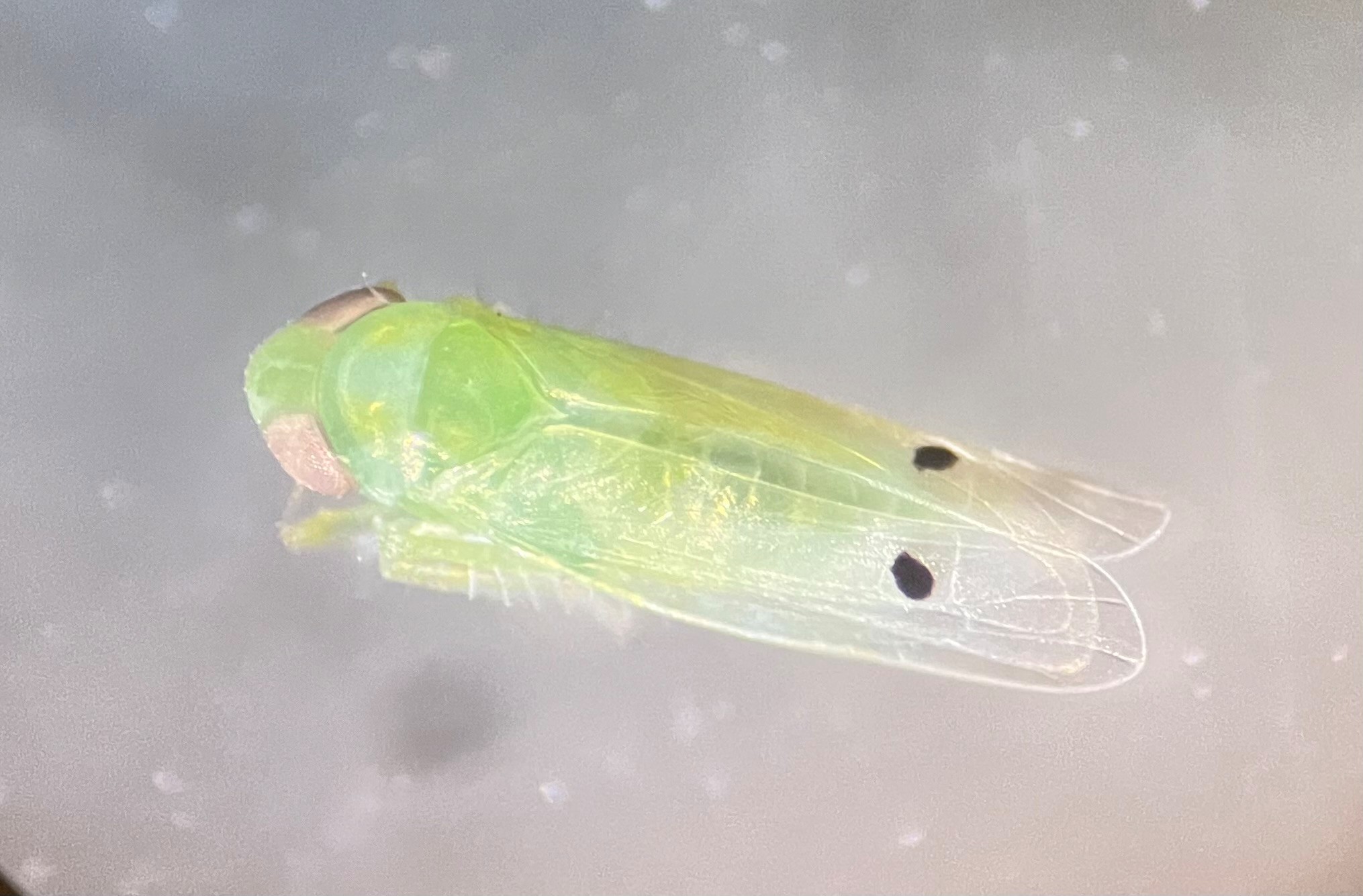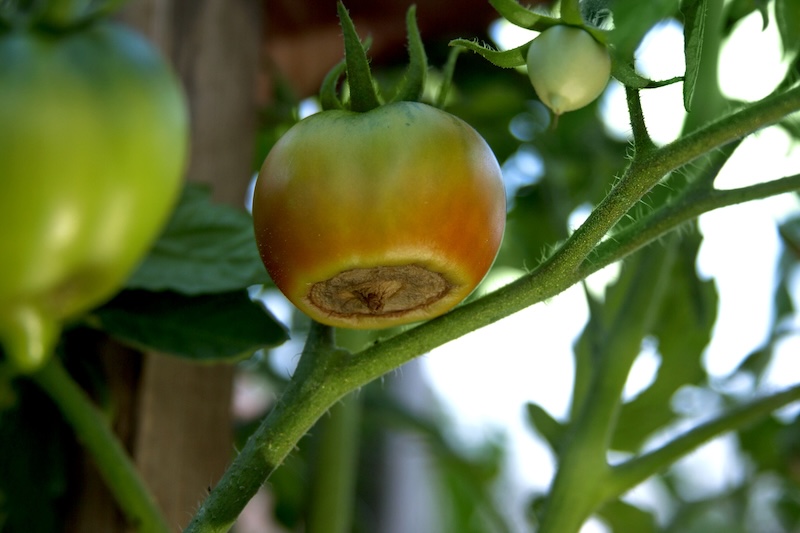The two-lined spittlebug (Figure 1), Prosapia bicincta (Hemiptera: Cercopidae), is an important insect pest of turfgrass in Georgia. It attacks all turfgrass species, but centipedegrass is the most susceptible to spittlebug infestation. It also attacks some ornamental plants, including asters, hollies, and morning glories.
The two-lined spittlebug injects toxins into turfgrass, and the affected grass blades turn yellow and then brown or purple. The damage symptoms start with the development of discolored leaves followed by the complete wilting of the stem and leaves, ultimately causing the death of the grass. The development of these symptoms is positively correlated with the number of spittlebugs feeding. Heavy infestations of two-lined spittlebugs can produce excessive spittle masses in the lawn, resulting in a squishy feeling when walked upon (Figure 2).
The feeding damage caused by nymphs and adults can be confused with water deficiency symptoms. Adults do more damage than nymphs. The adults cause economic damage to ornamental hollies, Ilex spp.—American holly and Burford holly in particular. Furthermore, the adult-mediated damage has also been recorded on some perennial or annual hosts.


Biology
The two-lined spittlebug is most active during the spring and summer months, completing its life cycle in less than 50 days. The two-lined spittlebug life cycle has three stages: egg, nymph (four nymphal stages) and adult (Figure 3).
A female lays up to 40 eggs during its lifetime. The orange-colored eggs are laid in the base of the grass near the soil surface. Sometimes, eggs are found between the stem and leaf sheath, but they are rarely inserted into the stem. The eggs, usually laid singly or in clusters, are around 0.04 in. in length and 0.01 in. in width.
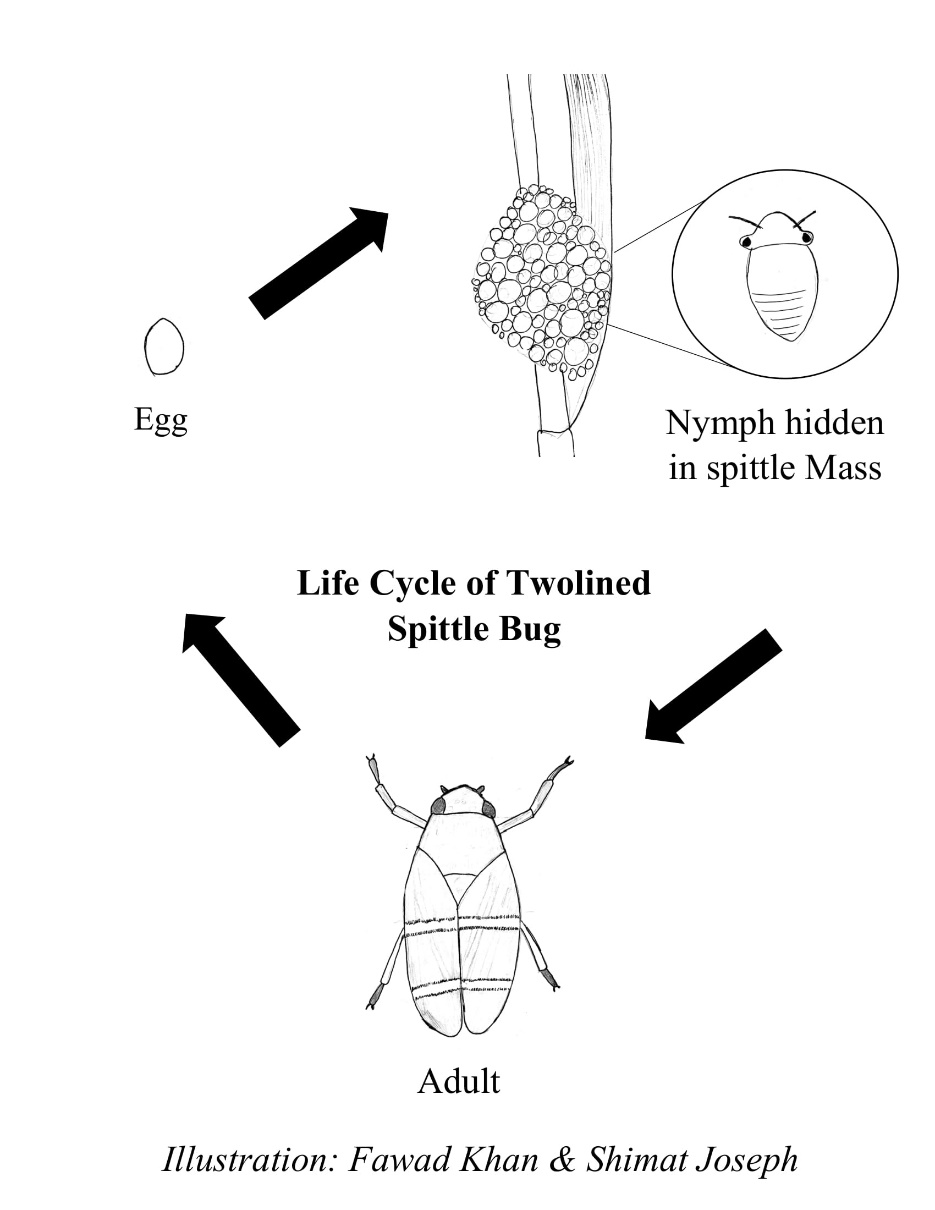
Figure 3. Life Cycle of the Two-Lined Spittlebug.
The two-lined spittlebug hatches in spring from the overwintering egg stage. Soon after hatching, the nymph moves onto the host and starts feeding. The creamy yellow nymph makes the foam-like, frothy, white spittle mass that gives the insect its common name after 5 min of active feeding (Figure 4). The formation of the spittle mass is considered a defensive strategy by immatures to avoid attack by natural enemies as well as to prevent desiccation. More than one nymph can be found in a single spittle mass. The wing pads are more prominent in the third nymphal stage compared to the earlier nymphal stages. The nymphal period lasts from 34 to 60 days depending on temperature.
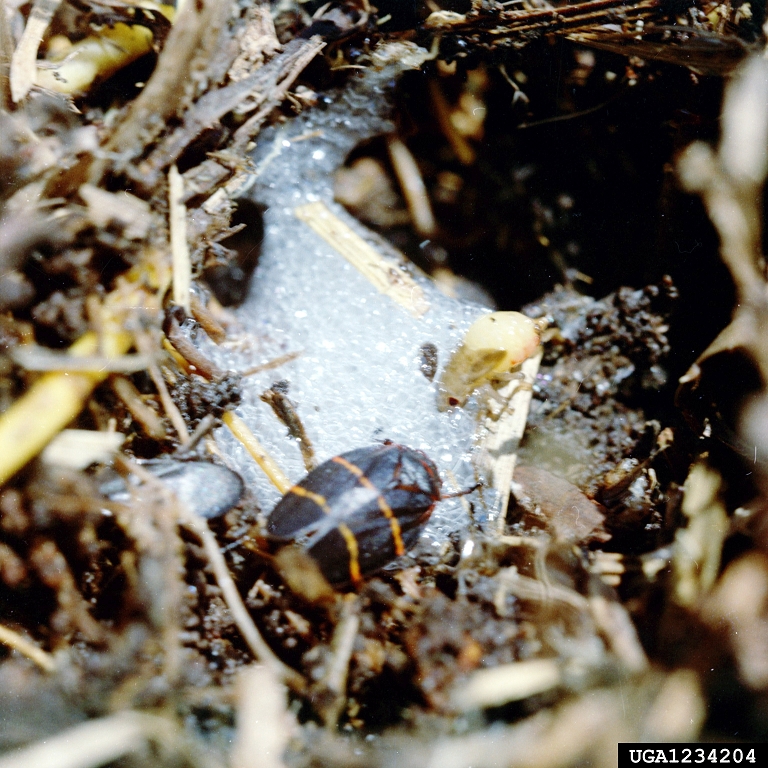
Adults, usually 3/8 in. long, are more conspicuous and active. The black wings are covered with two orange lines, hence the name “two-lined” spittlebug. The top of the abdomen, exposed when the wings are spread in flight, is a bright scarlet-red color. The adults have a longer lifespan, and at a temperature range of 72 to 95 °F, they can survive up to 42 days. However, at a lower temperature of 41 °F, the adult population does not survive beyond 2 weeks.
Management Strategies
Centipedegrass is the most susceptible turfgrass to two-lined spittlebug. Resistant cultivars are not commercially available, although there are several promising lines of centipedegrass and bermudagrass identified through research.
Biological control is usually ineffective for managing nymphal and adult populations of the two-lined spittlebug. The spittle mass provides protection to nymphal stages from predators. Although the adults actively jump when threatened and have bright coloration (aposematic coloration), acceptability to predation is still unclear.
The southern meadowlark, Sturnella magna argutulla (Bangs), is a bird species known to feed on two-lined spittlebugs. Moreover, the egg stage is attacked by red imported fire ants, carabid beetles, and big-eyed bugs. When exposed to tiger beetles, nymphs and adults were attacked in laboratory conditions. However, there is no substantial evidence that two-lined spittlebugs are being attacked by beneficial arthropods in field conditions.
Excessive thatch provides favorable conditions for two-lined spittlebug populations to develop. Therefore, chronic spittlebug problems can often be eliminated by reducing thatch. Damage can be identified by the presence of the purple to brown stripes on the grass blades. The grass can also be inspected for the presence of spittle masses or the actively jumping adults.
Cultural management includes dethatching affected spots and top dressing with sand or a soil mix. A two-lined spittlebug population increase is usually observed when there are frequent, consecutive rain events in the summer months.
If the population size increases, insecticide applications are advised. Contact your county Extension office for pesticide recommendations. A thorough watering may increase insecticide coverage and the effectiveness of the insecticide spray used. Early evening applications are more effective than morning sprays.
References
Beck, E. W., & Skinner, J. L. (1972). Seasonal light-trap collections of the twolined spittlebug in southern Georgia. Journal of Economic Entomology, 65(1), 110–114. https://doi.org/10.1093/jee/65.1.110
Braman, S. K., Hanna, W. W., Schwartz, B., & Nair, S. (2014). Evaluation of Chinese centipedegrasses and other turfgrass taxa for potential resistance to twolined spittlebug, Prosapia bicincta (Say). Journal of Entomological Science, 49(2), 121-129. https://doi.org/10.18474/0749-8004-49.2.121
Byers, R. A., & Wells, H. D. (1966). Phytotoxemia of coastal bermudagrass caused by the two-lined spittlebug, Prosapia bicincta (Homoptera: Cercopidae). Annals of the Entomological Society of America, 59(6), 1067-1071. https://doi.org/10.1093/aesa/59.6.1067
Fagan, E. B., & Kuitert, L. C. (1969). Biology of the two-lined spittlebug, Prosapia bicincta, on Florida pastures (Homoptera: Cercopidae). The Florida Entomologist, 52(3), 199. https://doi.org/10.2307/3493854
Genung, W. G., & Green, V. E. (1974). Food habits of the meadowlark in the Everglades in relation to agriculture. Environmental Entomology, 3(1), 39-42. https://doi.org/10.1093/ee/3.1.39
Layton, B. (2009). Control insect pests in and around the home lawn (Publication No. P2331). Mississippi State University Extension. http://extension.msstate.edu/node/6939
Nachappa, P. (2004). Biology and management of twolined spittlebug, Prosapia bicincta (Say)(Hempitera: Cercopidae), in turfgrass [Unpublished doctoral dissertation]. University of Georgia.
Nachappa, P., Guillebeau, L. P., Braman, S. K., & All, J. N. (2006). Susceptibility of twolined spittlebug (Hemiptera: Cercopidae) life stages to entomophagous arthropods in turfgrass. Journal of Economic Entomology, 99(5), 1711-1716. https://doi.org/10.1093/jee/99.5.1711
Pass, B. C., & Reed, J. K. (1965). Biology and control of the spittlebug Prosapia bicincta in coastal bermudagrass. Journal of Economic Entomology, 58(2), 275–278. https://doi.org/10.1093/jee/58.2.275
Shortman, S. L., Braman, S. K., Duncan, R. R., Hanna, W. W., & Engelke, M. C. (2002). Evaluation of turfgrass species and cultivars for potential resistance to twolined spittlebug (Hemiptera: Cercopidae). Journal of Economic Entomology, 95(2), 478–486. https://doi.org/10.1603/0022-0493-95.2.478
The thumbnail image for this publication is by Johnny N. Dell, Bugwood.org.





